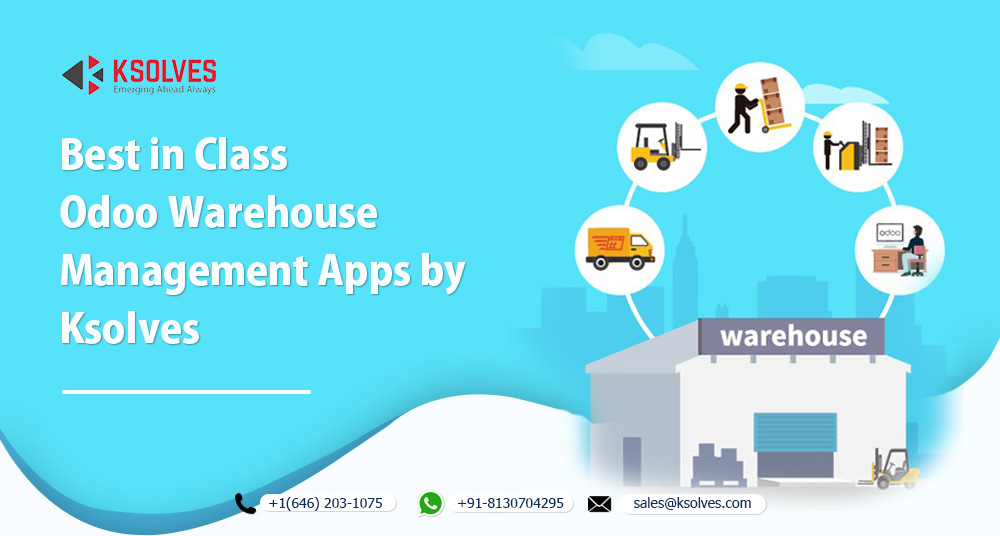Best in Class Odoo Warehouse Management Apps by Ksolves
Odoo
5 MIN READ
November 2, 2020
![]()

There’s an evolution in the IT industry with the continuous and steady progression from conventional software to cloud computing. In the cloud computing model, the vendor is accountable for everything, servers, storage, backups, system updates, applications, databases, and even maintenance. This eliminates customers’ need to buy, deploy, and manage IT services, saving enormous deployment costs and maintenance.
WMS and Supply Chain Management
In Supply Chain Management, the manufacturing of raw materials from the supplier’s distribution to the retail location; these are all aspects of this chain. The best thing about supply chain management is that it never stops. It works 24/7 and 365 days without any delay, and a small error can cost millions of dollars to the suppliers and manufacturers. Supply Chain Management is not a thing that can be taken lightly whether you are running a warehouse, a brick and mortar store, or even an online store.
Supply Chain Management and IT
When we connect IT with Warehouse Management, an essential aspect of Supply Chain Management, the results come out with flying colors. There are innumerable Warehouse Management systems according to business requirements. But, when it comes to flexibility and feasibility in operations, Odoo Warehouse Management System is considered one of the best WMS. The ability to customize according to requirements is the fundamental aspect of Odoo that makes it smart and easy to integrate ERP.
Odoo Warehouse Management System systemizes and simplifies the whole process of managing your staff and tracking your stock levels to sync your inventory with real-time analytics to improve internal and external operations. Through Email, SMS, and notifications panel in Odoo, you can get all the warehouse panel details. In Odoo, automatic pay orders can be generated using reordering tools, the price list can be developed, and purchase tenders can be formed for better integration and support.
Odoo and Warehouse Management System
Odoo’s Warehouse Management includes essential features. Double-entry Warehouse Management System enables you to trace everything from the supplier to delivery agent and delivery agent to customer, which helps handle the inventory and workforce together. You can also manage multiple warehouses with the same system and apply replenishment alerts so that you get the notification before any product gets out of stock.
Here are the Best in Class Odoo Warehouse Management Apps by Ksolves
Warehouse Report
The best in class Odoo Warehouse Management app helps the user create Odoo inventory management reports in significantly less time without extra cost or technical knowledge. The warehouse report app by Ksolves provides flexibility to your business required to make quick changes to have access to essential information on demand. Odoo Warehouse and Inventory Management System give you a sorted and simplified interface where you can fetch reports easily. In the Odoo Warehouse Stock Management App, you can easily manage multiple warehouses that are a few clicks away. In Warehouse Management, Automation is required to reduce wastage and helps the user to fetch desirable results according to the system’s requirements.
Inventory Quality Check
Quality check is one of the major hurdles that e-commerce companies face while dealing with bulk inventory. Earlier, when e-commerce and IT was not in trend, companies used to manually check the quality of the product that was tiring, lethargic, and most of the time, it caused errors. When quality benchmarks like Six Sigma and Agile were introduced, companies started focusing on quality and quantity.
With the onset of e-commerce and Artificial Intelligence, inventory quality check becomes the need of the hour. Most organizations started looking for the best app to integrate all the Warehouse Operations and Inventory Management altogether. Inventory Quality Check App by Ksolves is considered one of the best apps that can quickly provide vital insights into the inventory.
Ksolves Quality Check App for Inventory lets users manage quality teams, centers, checks, and alerts for Inventory. If the check fails, the Quality Alert is displayed, which needs to be resolved by the Quality teams.
Multi-Company Inventory Transfer
Ksolves’ Multi-Company Inventory Transfer App helps the user to maintain the inventory transactions between multiple companies. With Odoo default modules, a user cannot transfer product inventories between the same companies through a single step. The user has to create some complex rules to do so.
Ksolves’ Multi-Company Inventory Transfer App lets users transfer products between different warehouses of the same company in a single step with a feature of viewing the inventory movements in the Odoo warehouse management system.
Another major issue the user faces with the default module is the lack of features to transfer product inventories between different companies. Ksolves’ transfer app lets users transfer products between other companies’ warehouses in a single step with a feature of viewing the inventory movements.
Benefits of Warehouse Management Apps
1. Easy to Operate
Odoo is considered as one of the simplest ERP because it is easy to integrate and operate. A user doesn’t require any special training like other ERPs for every function. Odoo provides a demo for every function to its users to get a hands-on experience before stepping into the original ERP. Through its unique features and easy to use functionalities, a small business doesn’t require any extra hand to operate Odoo. Odoo for Small Business has turned out to be a boon for many business owners suffering cost issues because they had to hire special operators for ERP management and reporting.
2. Budget-Friendly
Derived from the above feature, Odoo is budget-friendly. The enterprise version hardly costs 12$, and any organization can go for it. Also, the community edition of Odoo is free of cost. In the Warehouse Management System, budget and reporting are significant because a small glitch can cost millions of dollars. Through Odoo ERP, the business owners benefit from operating more than 35 modules at one ERP, and they can easily track their inventory, sales, accounting, and even profit and loss through Odoo ERP.
3. Easy Cost Evaluations
Odoo supports cost evaluation methods like FIRST IN FIRST OUT (FIFO), Average Cost Methods, and Standard Price for product costing methods. Through Odoo, you can use many traceability features like ‘Lots Tracking,’ ‘Activity Log,’ ‘Serial Numbers,’ ‘Perpetual Valuation’ to make Warehouse Management easy.
4. Systematic Approach
With Odoo ERP Warehouse Management System gets the systematic approach. It achieves all the real-time information necessary for the next action, and the company avoids problems like out of stock products, backorders, lost sales, and dissatisfied customers.
5. Avoids Wastage
In Supply Chain Management, Perishable products are of high importance. Unprocessed foods and meats have a limited shelf life, and if they are not delivered in a specific period, the products will go stale, leading to loss of time and money. In this aspect, Odoo for small business turns out to be a lifesaver for many organizations who have just stepped into warehouse management and Supply Chain Management. With the help of Odoo technology and advanced features, the warehouse owners can mitigate the wastage of perishable goods. In Odoo, you can manage a defected or scrap product from any business point like receiving a good, or during internal transfer, etc.
6. Rental Opportunities
With the onset of 2020, because of COVID19, many SMEs have to face a severe financial crisis. Those businesses with multiple and small warehouses suffered because only essential goods and items were transported in many countries. There are many extensions on Odoo that add the rental feature in the Odoo ERP through which warehouse owners can rent their warehouses, machinery, and other inventories to other business owners and earn a stable income even in the lockdown period.
7. Workforce Monitoring
The significant difference between the inventory management system and a warehouse management system is workforce management. Through Odoo Warehouse Management System, the warehouse owner can easily track the employee’s activity through barcode scanning, check the delivery status, and fetch the system’s reports. When the Warehouse Management System is connected with Payroll Management System, the Human Resource Department can easily create its payroll. Using Odoo will allow you to precisely schedule the job, analyze your efficiency, and ease when realizing each step of your manufacturing process.
Conclusion
As we understand, the Warehouse Management System is the central part of Supply Chain Management, and it cannot be ignored at any cost. WMS has become an essential need of a warehouse owner, and Odoo contributes a lot to the Supply Chain Management Module. The single ERP can handle all the crucial operations in a business and can provide seamless integration with any module you require for your business.
Related Articles:
New Features of Odoo 14 Accounting
Difference Between Odoo 14 Enterprise and Community Edition
![]()
Latest Post
AUTHOR

Odoo
Neha Negi, Presales and Business Associate Head at Ksolves is a results-driven ERP consultant with over 8 years of expertise in designing and implementing tailored ERP solutions. She has a proven track record of leading successful projects from concept to completion, driving organizational efficiency and success.




Looking for dashboard demo as we need to purchase for integration in our ERP